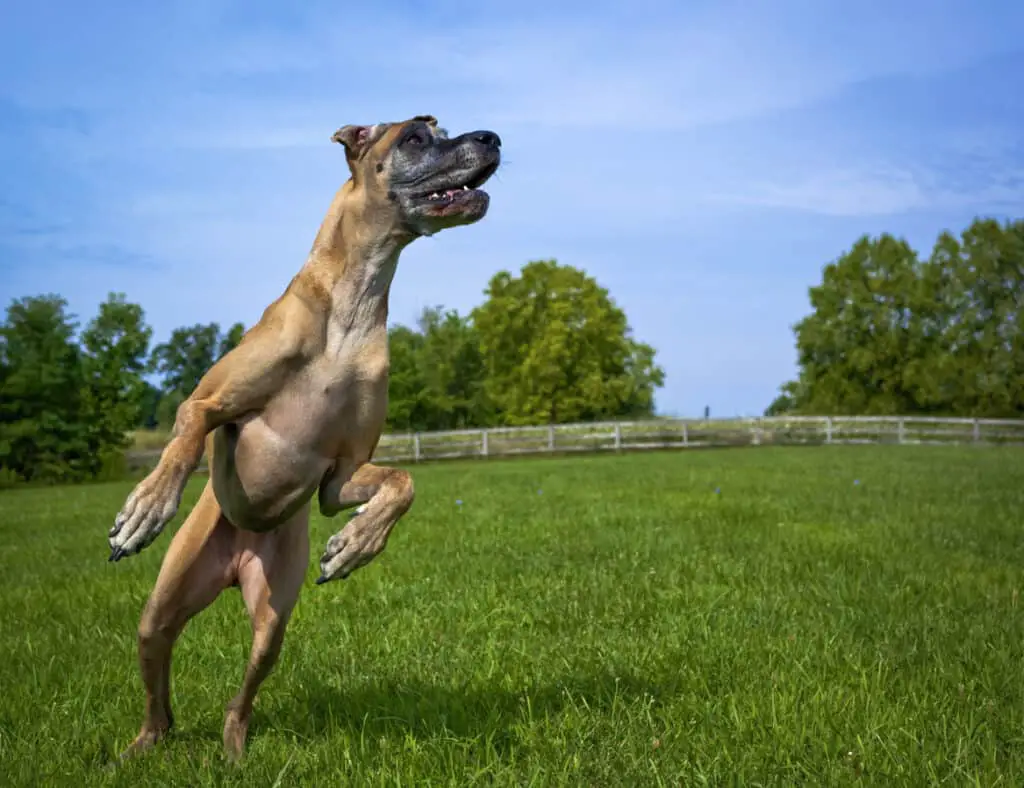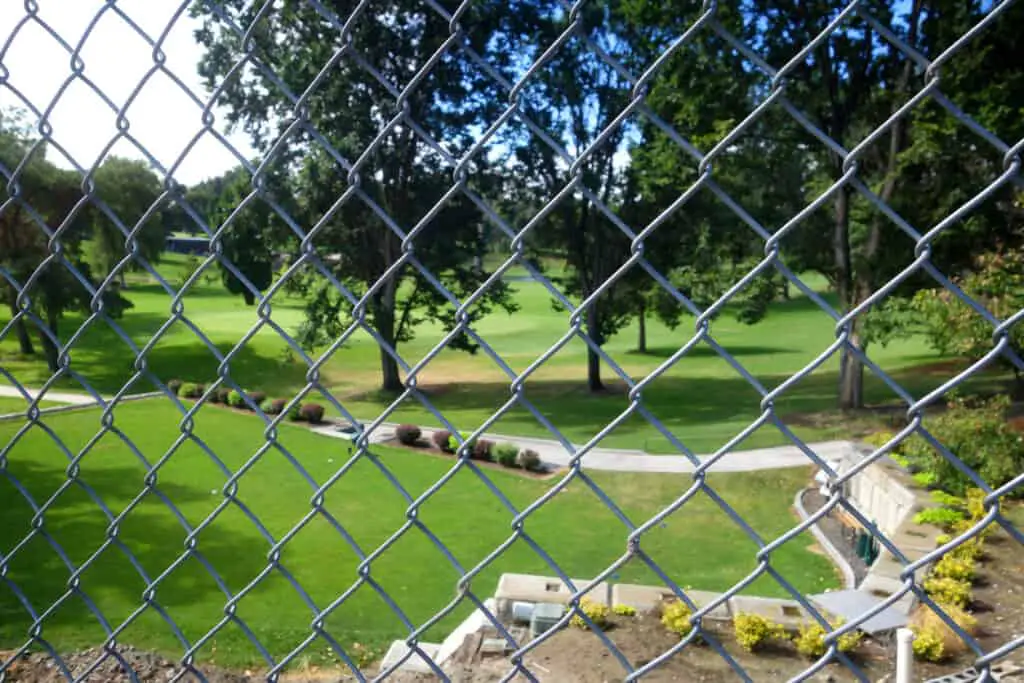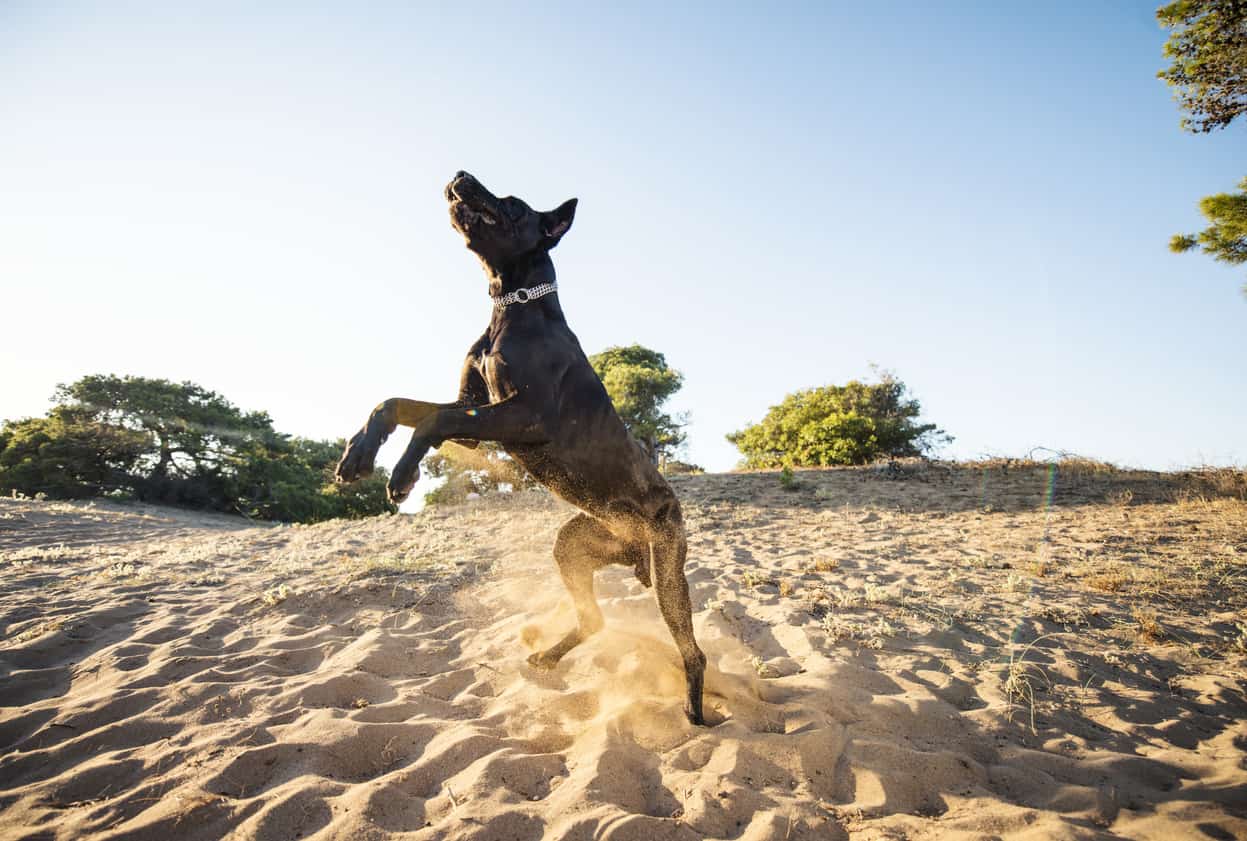Great Danes are one of the most family friendly dogs out there thanks to their loyal and affectionate temperaments. Their size always draws attention too – with males standing a minimum of 30-32 inches at the shoulder and females at least 28-30 inches, it’s virtually impossible for passerby not to notice this majestic and athletic-looking breed.
Adult Great Danes can jump anywhere from 2 feet to 5 feet in the air. Since they have long legs, sometimes it is dangerous for them to land on a hard surface.
Of course, Great Danes aren’t always majestic looking. As puppies they can be downright clumsy, tripping over their own large paws as they run and jump about. While their antics might be cute and endearing when they’re young, it would behoove owners to carefully monitor their young Great Dane’s interest and predisposition to jump. Many bad habits that puppies pick up are a result of boredom or the behavior not being corrected early on.
Will Great Danes jump fences?

Yes, as a breed, Great Danes are extremely curious. They are also extremely inclined towards athletic activity, even if they tend to be clumsy in their execution. These traits combined with their size can make keeping them contained a challenge, which is why it’s so important to take note when they’re young and break them of any bad habits you see forming.
Adult Great Danes can easily clear fences between five and six feet tall, especially when they’re motivated by adrenaline. In the case of intact females or males, their escape mechanisms may be activated by their instinct to roam when they’re in heat (females) or if they sense a female in heat nearby (males). In many cases, it an simply be enough that they smell or see or hear something interesting, and feel compelled to investigate. Great Danes are extremely curious and will naturally pursue whatever has caught their attention if possible.
Jumping fences is extremely dangerous for Great Danes, for a number of reasons. Firstly, they can get lost, and while it’s unlikely that they’ll remain lost for very long once word gets out that a massive dog is on the loose, every minute spent unsupervised increases the danger of getting into a car accident or encountering something dangerous. While Great Danes are not naturally aggressive, they can still get into fights with other dogs. Additionally, they may cause accidental harm to people through their sheer giddiness at being “free.” Without an owner to restrain or regulate their behavior, an exuberant Dane can easily knock over anyone they might encounter, including children and elderly people.
How to prevent jumping

To counteract your Great Dane’s natural urge to leap over obstacles in its path, dissuade the behavior from the moment you notice it. For example, if your Great Dane puppy rears up on his hind legs to greet you, gently but firmly hold its front paws so that it’s forced to stand on hind legs. This feels unnatural and forces the weaker muscles in the hind legs to work, which has a two-fold benefit.
First, if this is your consistent response over time, your Great Dane will come to associate leaping up with discomfort and will cease the behavior. Additionally, holding your dog’s paws strengthens the weaker hind legs, which is good for the overall health of a Great Dane due to the breed’s predisposition for hip dysplasia and other joint-related issues.
It is important that you perform the act of holding their paws neutrally – if your Great Dane feels that you are doing it vindictively or in punishment, they could generalize and become mistrustful of your motives when you interact with them in general.
Be aware of what triggers jumping in your Great Dane

If your Great Dane becomes excited when other dogs are being walked and begins to race the fence line as soon as it smells them, that may be a sign to keep your Dane indoors during peak walking hours. The same goes for children – Great Danes are known for their love of children, and they may become overexcited if they can hear and smell them getting on and off school buses, but not be able to play with them. If this is the case, keep them inside during these times.
You may also want to talk with the children or the parents of the school children about proper etiquette when your dog is in the yard. Many children mean no harm, but can intentionally seek to rev up your dog by calling its name, making noise, and generally causing a lot of excitement in your Great Dane.
It’s important that the time your Great Dane spends inside to regulate its jumping does not take way from time it would otherwise be getting exercise. As the old adage goes, “A tired dog is a good dog.” Ensuring that your Great Dane has a rigorous (but developmentally appropriate) exercise routine is a great way to disperse interest in jumping before it occurs.
Another potential factor that may trigger jumping in your Great Dane may be separation anxiety. Danes are highly sensitive and social pets that do very poorly when left alone for too long. Issues may arise here when an owner and their Great Dane have different definitions of “too long.” For example, you may think you’re meeting your Great Dane’s needs by playing fetch for ten minutes and then going back inside to leave your Dane to its own devices, but in reality, healthy adult Danes need at least 30-60 minutes of exercise every day. Puppies, with their varying levels of energy and tendency toward hyperactivity, may need anywhere from 30-120 minutes.
Separation anxiety can lead a Great Dane to leap the fence in an attempt to find another way into the home, but they can quickly become distracted with all of the exciting smells outside the bounds of their territory and wander off. Separation issues also overlap with boredom due to the effect boredom has on inspiring naughty behavior in Great Danes.
Great Danes that develop the bad habit of jumping over fences are at increased risk of physically hurting themselves. Although they can easily clear high hurdles, the stress these massive leaps place on their large bodies is absorbed by their joints and bones, which aren’t designed for such agility. This is of particular concern with Danes that are in their growth phase but still maturing, so typically between 6-24 months.
A note on electric fences
These fences, often called “invisible fences” may seem like a natural solution to dog owners who don’t want to build sky-high fences and want to keep their yard looking inviting and open. Unfortunately, these collars are often inhumane and ineffective solutions to Great Danes – their size makes it certain that if they are truly intent on chasing a squirrel or a cat, or pursuing something of interest beyond the bounds of the electric fencing, they are capable of ignoring the corrective shock.
When is it time to consult a professional?
As mentioned previously, Great Danes that develop the bad habit of escaping by jumping over fences are at risk of several issues occurring. If your corrections aren’t working and your Dane is regularly putting itself (and others) in potentially dangerous situations by going on solo jaunts, it may be time to recruit the help of a canine professional who can help you correct the behavior and implement new systems to manage and maintain the desired behavior.
These corrections will often involve lifestyle adjustments between the dog and the owner more broadly, such as incorporating more walks into the day, longer play sessions, and working to identify the particular jumping triggers in your particular Great Dane. Although costly, a good trainer experienced with Great Danes can be an effective solution for resolving unwanted behavior in a way that strengthens the bond between you and your Great Dane. This will ultimately make you a better owner, too.
How to raise a Great Dane that doesn’t jump over fences
From the get-go, investing in proper fencing is a great first step. Installing a six or seven-foot-high wooden privacy fence is an excellent deterrent to the always curious Great Dane, although introducing a dog to such high fencing right out of the gate may encourage other unwanted behaviors, such as digging and chewing the fence.
Socialization is key to raising healthy Great Dane puppies for a number of reasons, but there are several advantages to socializing a Great Dane puppy as it pertains to dissuading jumping.
Taking the time to properly introduce your Great Dane to as many novel stimuli and experiences as possible (without overwhelming them, of course) will make them less likely to view mundane events such as the neighbor’s dog walking by with great excitement. Additionally, socializing a Great Dane as a puppy has the added benefit of instilling a better sense of understanding of the world in an adult Great Dane, which makes it less threatening and agitating.
In conjunction with socialization, it is essential to properly train your Great Dane puppy. These adorable gentle giants weigh anywhere from 110-200 pounds when fully grown, and it is much easier to train a puppy than to retrain a recalcitrant adult. One of the most important aspects of training related to preventing jumping behaviors is leash training.
The reason for this is that dog walking quickly becomes a challenge if a puppy is not properly trained, particularly when that puppy becomes an adult Great Dane. Thus, problems from walking often expand to include other behavioral problems rooted in an owner’s (understandable) reluctance to attempt to walk a poorly leash-trained Great Dane. Resorting to simply turning out the dog in the yard can result in separation anxiety and/or boredom, which in turn could cause your Great Dane to get up to some jumping mischief.
Teaching and incorporating regular obedience training into your Great Dane puppy’s schedule will also serve owners well. Obedience training makes a dog more responsive to and trusting of an owner’s commands, as well as receptive to learning new skills – such as “down.”
A special collar – just in case
No, not a shock collar. Rather, a GPS collar that can help you locate your Great Dane should the need ever arise can help put you at ease if you’re attempting to cure a Great Dane of a case of the escape jumpies. Although these collars can be a bit pricey, they’re arguably priceless in helping you locate an escaped Great Dane in minimal time and prevent a potential accident or harm from befalling it.
Ultimately, jumping is far from simply a “bad” behavior, but it is certainly a bad habit that should be addressed promptly should it arise.

